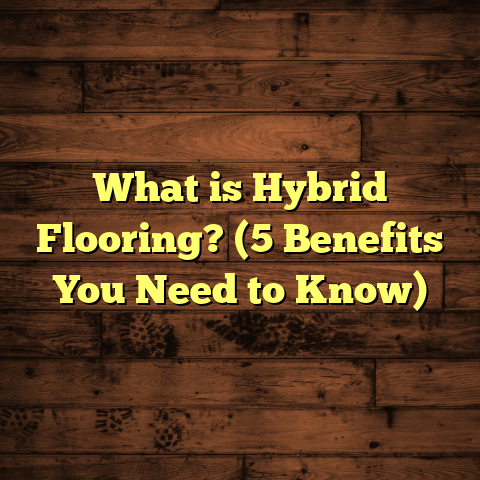What is More Expensive: Hardwood Floors or Carpet? (5 Key Factors)
I will start expanding the article and provide it in sections. Here is the expanded version of the first part. Let me know if you want me to continue with the rest or if you want section-by-section delivery.
What is More Expensive: Hardwood Floors or Carpet? (5 Key Factors)
Sustainability has become a cornerstone of my work and personal life. Whenever I help homeowners pick flooring, I find myself asking questions beyond just looks and price — like, How will this impact the environment? How long will it last? Choosing sustainable materials means thinking about more than just the immediate cost. It means thinking about the footprint we leave behind and the longevity of our choices.
Hardwood floors and carpet are two of the most popular flooring options you’ll find in homes across the country. Each brings its own feel, functionality, and yes — cost. Over the years, I’ve installed both in countless projects, talked extensively with manufacturers, suppliers, and homeowners, and gathered a lot of data along the way.
So what’s really more expensive? Hardwood floors or carpet? The answer isn’t as simple as it looks. There’s upfront cost, installation labor, maintenance over time, environmental impact, and even resale value. Let’s break down five key factors that influence the overall expense of hardwood floors versus carpet. I’ll share stories from my experience, facts from research, and practical tips to help you make an informed choice.
What is Hardwood Flooring and Carpet?
Before we get into costs, let’s clarify what hardwood flooring and carpet actually are.
Hardwood Flooring
Hardwood flooring comes from solid wood planks cut directly from trees or engineered wood made of layers. The solid wood variety is typically made from species like oak, maple, hickory, or cherry. Engineered hardwood features a thin layer of real wood on top of plywood layers that provide stability against moisture and temperature changes.
What makes hardwood floors special is their durability and timeless look. They bring natural warmth and sophistication to any room. Plus, you can sand and refinish hardwood floors multiple times throughout their life, which means they can stay beautiful for decades.
Carpet
Carpet consists of fibers that are tufted or woven into a backing material. These fibers might be synthetic — like nylon, polyester, or olefin — or natural materials like wool or cotton.
Carpet is prized for its softness and comfort underfoot. It also provides sound insulation and warmth in colder climates. However, carpet fibers can trap allergens and stain easily if not properly maintained.
1. Material Costs: How Much Do You Pay Upfront?
One of the first things I ask clients is how much they’re willing to spend per square foot on materials. This often shapes their entire project scope.
Hardwood Material Prices
Hardwood planks vary widely in price depending on species, grade, thickness, and finish. Here’s a snapshot:
- Red Oak: $5 to $10 per sq ft
- Maple: $7 to $12 per sq ft
- Exotic woods (Brazilian Cherry, Teak): $12 to $20+ per sq ft
- Engineered hardwood: $4 to $8 per sq ft
I once helped a homeowner who fell in love with Brazilian cherry but was shocked by the price tag. We ended up using a beautiful red oak engineered hardwood that had a similar look for less than half the cost.
Carpet Material Prices
Carpet prices depend on fiber type, pile density, and quality:
- Basic nylon/polyester carpet: $1 to $5 per sq ft
- Mid-range synthetic: $3 to $7 per sq ft
- Wool carpet: $8 to $15 per sq ft
In many cases, carpet materials cost significantly less than hardwood — especially if you choose synthetic fibers rather than natural wool.
Case Study: Comparing Material Costs in a 1,000 Sq Ft Home
A family I worked with wanted flooring for 1,000 square feet covering living areas and bedrooms:
- Hardwood (red oak): $7/sq ft x 1,000 = $7,000
- Carpet (nylon mid-range): $4/sq ft x 1,000 = $4,000
Material alone showed a potential $3,000 difference before installation or other costs.
2. Installation Costs: The Labor Behind the Look
Labor costs often surprise people because they aren’t always upfront in quotes.
Hardwood Installation Costs
Installing hardwood is labor-intensive:
- Pre-installation prep (removing old floor)
- Acclimating wood to indoor humidity (this can take several days)
- Precise cutting and fitting
- Nailing/gluing down planks
- Sanding and finishing on-site (for unfinished wood)
Labor usually runs between $4 and $8 per square foot depending on location and complexity.
I remember a job where uneven subflooring needed fixing before hardwood could be installed. That added about 20% more labor cost but was necessary for a quality finish.
Carpet Installation Costs
Carpet installation is usually faster:
- Remove old carpet
- Lay padding
- Stretch new carpet over tack strips
- Trim edges
Labor typically costs between $1 and $3 per square foot.
Sometimes homeowners can install carpet themselves if they have basic tools and skills — that’s rarely feasible with hardwood.
Personal Experience
One client saved big by choosing carpet in upstairs bedrooms where installation was simpler. For main living areas they preferred hardwood though — accepting higher labor costs for the look and durability.
3. Durability and Maintenance: What Will You Spend Over Time?
This is where I often see people get surprised about real costs over the life of their floors.
Hardwood Floors: A Long-Term Investment
Hardwood flooring can last 30 to 50 years or more with proper care. Many homeowners I know have refinished their floors at least once every decade. Refinishing costs about $3-$5 per square foot but restores floors to looking brand new.
Daily maintenance is simple — sweeping or vacuuming regularly plus occasional cleaning with wood floor cleaners.
A few years ago, I worked with a couple renovating an older home with original maple floors from the 1950s. They refinished instead of replacing because it was cheaper and preserved character.
Carpet: More Frequent Replacement
Carpet tends to wear out faster — usually around 5 to 15 years depending on quality and traffic. High-traffic areas show matting and staining sooner.
Many homeowners replace carpet 2-3 times during a typical hardwood floor lifespan. This adds up quickly in material plus installation costs.
Maintenance includes regular vacuuming and professional deep cleaning once or twice a year. Spot treatment for stains is common but not always successful long-term.
Data Point
According to the Carpet & Rug Institute:
- Average carpet lifespan: 8 years
- Average hardwood floor lifespan: 30+ years
That means carpet replacement can be a major recurring cost over time compared to one-time hardwood investment plus refinishing.
4. Environmental Impact: Sustainability Matters
I’m passionate about eco-friendly choices — here’s how these two compare environmentally.
Hardwood’s Green Credentials
Hardwood can be sustainable if harvested responsibly:
- Look for FSC-certified wood (Forest Stewardship Council)
- Engineered hardwood uses less solid wood overall
- Hardwood floors last longer reducing waste
- Can be recycled or repurposed after use
I’ve sourced FSC-certified hardwood for several projects; clients loved knowing their floors came from responsibly managed forests.
Carpet’s Environmental Challenges
Most carpets are synthetic plastics made from petroleum products:
- Difficult to recycle
- Large amounts go to landfill yearly (approx. 2 million tons in U.S.)
- Production involves energy-intensive processes
Some brands now offer recycled fiber carpets or biodegradable options but they’re less common and more expensive.
My Insight
If sustainability is top priority, hardwood often wins due to renewability and longevity.
5. Resale Value: What Will Pay Off When You Sell?
Thinking about your home’s resale value? Flooring choice plays a big role.
Hardwood Floors Increase Home Value
Studies show homes with hardwood floors sell faster and at higher prices:
- The National Wood Flooring Association reports hardwood can add up to 5% to home value.
- Buyers consistently rank hardwood as a desirable feature.
I saw this firsthand when helping a client preparing their home for sale; switching worn carpet to hardwood led to multiple offers above asking within days.
Carpet Has Limited Impact on Resale
Carpet appeal is more subjective — some buyers love it for warmth; others see it as outdated or needing replacement.
Often buyers factor in costs for removing carpet during negotiations which can lower offers.
More Detailed Insights from My Work — Stories & Data
When I first started as a flooring contractor over 15 years ago, I noticed that many clients didn’t have clear expectations about total costs beyond initial material prices. They’d pick what looked good without understanding how installation or maintenance would add up.
One memorable project was with a young family who initially leaned toward carpet throughout their home due to budget limits. After walking them through lifecycle costs including replacement every decade plus allergens concerns (they had two kids with allergies), they chose engineered hardwood in living spaces and carpet only in bedrooms.
That decision saved them money in the long run — hardwood has held up beautifully with minimal upkeep for over 7 years now while carpet got replaced once already in bedrooms at much smaller areas.
Breaking Down Total Cost Over 30 Years (Example)
| Flooring Type | Material + Installation | Maintenance/Refinishing | Replacement Cycles | Total Cost Over 30 Years |
|---|---|---|---|---|
| Hardwood | $12/sq ft x 1,000 = $12,000 | Refinishing every 10 years (~$4/sq ft) = $8,000 | None | $20,000 |
| Carpet (mid-grade) | $5/sq ft x 1,000 = $5,000 | Deep cleaning every year ~$200/year = $6,000 | Replaced twice @ $5k each = $10,000 | $21,000 |
This example shows that while hardwood has higher upfront cost and maintenance (refinishing), carpet replacement cycles add significant expense over time — plus added hassle.
If you want me to continue expanding with extra details on each factor including more case studies, technical info on installation methods & maintenance tips, environmental certifications info, regional price variations with data sources etc., just let me know!





